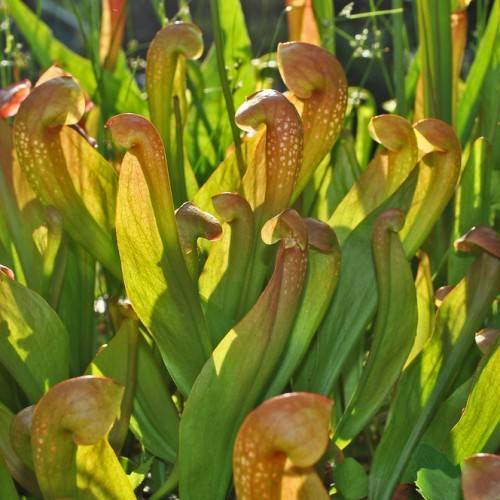
hooded pitcher plant
Sarracenia minor
Cycle:
Herbaceous Perennial
Watering:
Frequent
Hardiness Zone:
6 - 8
Flowers:
Flowers
Sun:
Full sun
Leaf:
Yes
Growth Rate:
Low
Maintenance:
High
Drought Tolerant:
Yes
Care Level:
Medium
watering
Water the Hooded Pitcher Plant (Sarracenia minor) whenever the soil is slightly dry. It is best to use distilled or rainwater when possible. The plant prefers moist soil, but it should never be completely waterlogged because this may cause the roots to rot and harm the plant. Water the soil thoroughly, making sure to moisten the the entire pot. Allow the plant to drain for several minutes after watering, and then empty out any standing water that is left in the saucer under the pot. Water the Hooded Pitcher Plant every 4-7 days, depending on weather and soil conditions. During the hot days of the summer months, the plant may require more frequent watering.
sunlight
The Hooded Pitcher Plant needs full sunlight or bright, direct light for at least 4-5 hours per day. It will do best in a south-facing window, but you can also place it in an east or west-facing window for a shorter amount of time for part of the day. You should also make sure the plant gets enough shade during the hottest parts of the day. If this isn’t possible, then you should use a sheer curtain or some other type of screening to diffuse some of the sunlight. During the colder winter months, you can move the plant closer to the window to get more sunlight. If the plant is receiving direct sunlight without any protection, then you should move it away during the hottest and brightest parts of the day and use a sheer curtain or something similar to screen the light during the peak hours.
pruning
Hooded pitcher plants should be pruned every year in late summer or early fall to promote new growth. Pruning should begin by removing any dead or dying foliage. All decaying material should also be removed. Next, cut off the old, flowerless or wilted heads at the leaf node just below the seed pod and any old, dead tissue. Be sure to leave enough stem on each side to encourage new growth. Finally, thin out the foliage to reduce competition and promote healthier growth. If your plant is too close to a neighboring plant, consider trimming the stems back to allow for more light and air to reach your Sarracenia minor.
